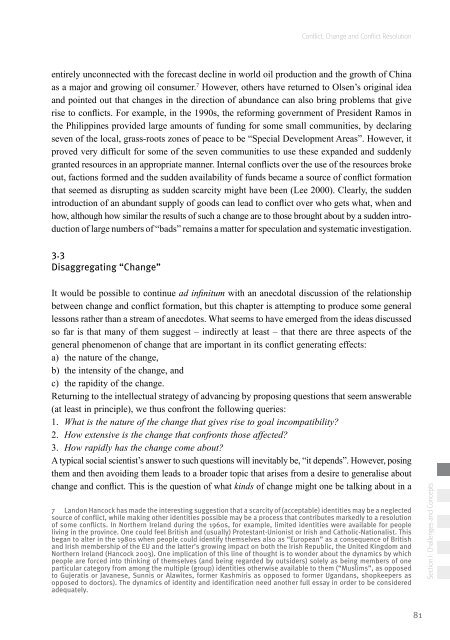Conflict, Change and Conflict Resolution - Berghof Handbook for ...
Conflict, Change and Conflict Resolution - Berghof Handbook for ...
Conflict, Change and Conflict Resolution - Berghof Handbook for ...
You also want an ePaper? Increase the reach of your titles
YUMPU automatically turns print PDFs into web optimized ePapers that Google loves.
<strong>Conflict</strong>, <strong>Change</strong> <strong>and</strong> <strong>Conflict</strong> <strong>Resolution</strong><br />
entirely unconnected with the <strong>for</strong>ecast decline in world oil production <strong>and</strong> the growth of China<br />
as a major <strong>and</strong> growing oil consumer. 7 However, others have returned to Olsen’s original idea<br />
<strong>and</strong> pointed out that changes in the direction of abundance can also bring problems that give<br />
rise to conflicts. For example, in the 1990s, the re<strong>for</strong>ming government of President Ramos in<br />
the Philippines provided large amounts of funding <strong>for</strong> some small communities, by declaring<br />
seven of the local, grass-roots zones of peace to be “Special Development Areas”. However, it<br />
proved very difficult <strong>for</strong> some of the seven communities to use these exp<strong>and</strong>ed <strong>and</strong> suddenly<br />
granted resources in an appropriate manner. Internal conflicts over the use of the resources broke<br />
out, factions <strong>for</strong>med <strong>and</strong> the sudden availability of funds became a source of conflict <strong>for</strong>mation<br />
that seemed as disrupting as sudden scarcity might have been (Lee 2000). Clearly, the sudden<br />
introduction of an abundant supply of goods can lead to conflict over who gets what, when <strong>and</strong><br />
how, although how similar the results of such a change are to those brought about by a sudden introduction<br />
of large numbers of “bads” remains a matter <strong>for</strong> speculation <strong>and</strong> systematic investigation.<br />
3.3<br />
Disaggregating “<strong>Change</strong>”<br />
It would be possible to continue ad infinitum with an anecdotal discussion of the relationship<br />
between change <strong>and</strong> conflict <strong>for</strong>mation, but this chapter is attempting to produce some general<br />
lessons rather than a stream of anecdotes. What seems to have emerged from the ideas discussed<br />
so far is that many of them suggest – indirectly at least – that there are three aspects of the<br />
general phenomenon of change that are important in its conflict generating effects:<br />
a) the nature of the change,<br />
b) the intensity of the change, <strong>and</strong><br />
c) the rapidity of the change.<br />
Returning to the intellectual strategy of advancing by proposing questions that seem answerable<br />
(at least in principle), we thus confront the following queries:<br />
1. What is the nature of the change that gives rise to goal incompatibility?<br />
2. How extensive is the change that confronts those affected?<br />
3. How rapidly has the change come about?<br />
A typical social scientist’s answer to such questions will inevitably be, “it depends”. However, posing<br />
them <strong>and</strong> then avoiding them leads to a broader topic that arises from a desire to generalise about<br />
change <strong>and</strong> conflict. This is the question of what kinds of change might one be talking about in a<br />
7 L<strong>and</strong>on Hancock has made the interesting suggestion that a scarcity of (acceptable) identities may be a neglected<br />
source of conflict, while making other identities possible may be a process that contributes markedly to a resolution<br />
of some conflicts. In Northern Irel<strong>and</strong> during the 1960s, <strong>for</strong> example, limited identities were available <strong>for</strong> people<br />
living in the province. One could feel British <strong>and</strong> (usually) Protestant-Unionist or Irish <strong>and</strong> Catholic-Nationalist. This<br />
began to alter in the 1980s when people could identify themselves also as “European” as a consequence of British<br />
<strong>and</strong> Irish membership of the EU <strong>and</strong> the latter’s growing impact on both the Irish Republic, the United Kingdom <strong>and</strong><br />
Northern Irel<strong>and</strong> (Hancock 2003). One implication of this line of thought is to wonder about the dynamics by which<br />
people are <strong>for</strong>ced into thinking of themselves (<strong>and</strong> being regarded by outsiders) solely as being members of one<br />
particular category from among the multiple (group) identities otherwise available to them (“Muslims”, as opposed<br />
to Gujeratis or Javanese, Sunnis or Alawites, <strong>for</strong>mer Kashmiris as opposed to <strong>for</strong>mer Ug<strong>and</strong>ans, shopkeepers as<br />
opposed to doctors). The dynamics of identity <strong>and</strong> identification need another full essay in order to be considered<br />
adequately.<br />
81<br />
Section I: Challenges <strong>and</strong> Concepts
















